Author | Jiawei @IOSG
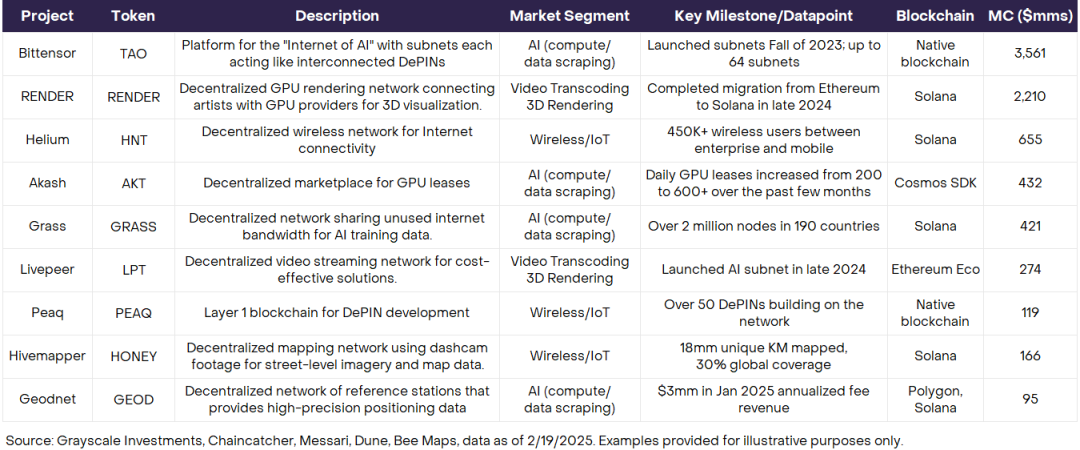
▲ Source: Grayscale
Grayscale wrote a research report on DePIN at the beginning of this year, and the table above shows the leading DePIN projects and their market capitalizations. Since 2022, DePIN and AI have been mentioned as two new directions for Crypto investment. However, it seems that there has not been a flagship project in the DePIN field. (Helium can be considered a leading project, but it appeared even before the concept of DePIN; the projects listed in the table such as Bittensor, Render, and Akash are more associated with the AI track.)
From this perspective, DePIN lacks a sufficiently strong leading project to break the ceiling of this track. There may still be some Alpha opportunities in the DePIN track in the next 1-3 years.
This article attempts to sort out the investment logic of DePIN from scratch, including why DePIN is an investment track worth our attention and proposing a simple analytical framework. Since DePIN is a comprehensive concept that encompasses many diverse sub-tracks, this article will slightly zoom out to explain the concept from an abstract perspective while still providing some specific examples.

Why Focus on DePIN Investment
DePIN is not a buzzword
First, it is important to clarify that decentralizing the infrastructure of the physical world is not a flashy idea, nor is it merely a "narrative play," but something that can be executed. There are indeed scenarios in DePIN where decentralization can "enable" something or "optimize" something.
Here are two simple examples:
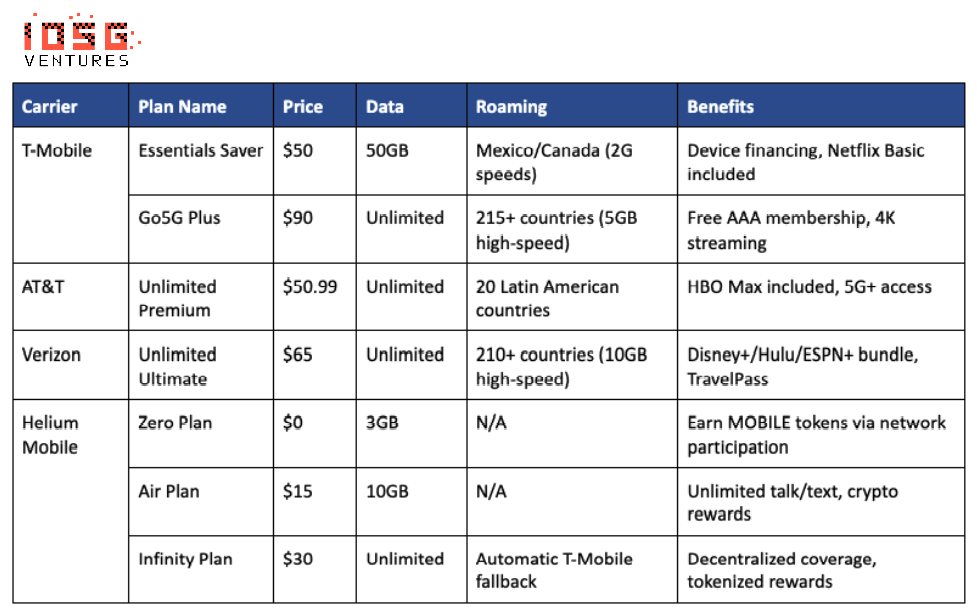
▲ Source: IOSG
In the telecommunications sector, a major track in DePIN, taking the U.S. market as an example, traditional telecom operators (such as AT&T, T-Mobile) often need to invest billions of dollars in spectrum license auctions and base station deployments, paying deployment costs of $200,000 to $500,000 for each macro base station covering a radius of 1-3 kilometers. In a 2022 auction by the U.S. Federal Communications Commission (FCC) for 5G spectrum in the 3.45GHz band, AT&T invested $9 billion, becoming the operator with the highest investment. This centralized infrastructure model leads to high communication service prices.
Helium Mobile, through community crowdsourcing, distributes this early cost among users, allowing individuals to access the network by purchasing hotspot devices for $249 or $499, becoming "micro-operators," and driving community self-organization through token incentives, thereby reducing overall investment. Verizon's cost to deploy a macro base station is about $200,000, while Helium can achieve similar coverage by deploying about 100 hotspot devices (total cost of about $50,000), reducing costs by approximately 75%.
Additionally, in the AI data field, traditional AI companies need to pay up to $300 million per year in API fees to platforms like Reddit and Twitter to obtain training data, and they rely on Bright Data (residential proxies) and Oxylabs (data center proxies) to scrape data. Moreover, they increasingly face more copyright and technical restrictions, making it difficult to ensure the compliance and diversity of data sources.
Grass has cracked this dilemma through distributed web scraping, allowing users to share idle bandwidth by downloading a browser extension to help scrape publicly available web data and earn token rewards. This model significantly reduces the data acquisition costs for AI companies while achieving data diversity and geographical distribution. According to Grass statistics, there are currently 109,755,404 IP addresses from 190 countries participating in the network, contributing an average of 1,000 TB of internet data daily.
In summary, a basic starting point for investing in DePIN is that decentralized physical infrastructure has the opportunity to perform better than traditional physical infrastructure, and even achieve things that traditional methods cannot.
Intersection of Infra and Consumer
As two main lines of Crypto investment, Infra and Consumer each face some issues.
Infra projects generally have two characteristics: first, they have strong technical attributes, such as ZK, FHE, MPC, etc., which have high thresholds and a certain disconnect in market perception. Second, apart from the familiar Layer 1/2, cross-chain bridges, staking, and other projects that can directly reach end users, most Infra projects are actually B2B. For example, developer tools, data availability layers, oracles, co-processors, etc., are relatively distant from users.
These two points make it difficult for Infra projects to drive user mindshare and have poor dissemination. Although high-quality Infra has a certain product-market fit (PMF) and revenue, allowing it to be self-sufficient across cycles, the lack of mindshare in a market with scarce attention makes it difficult to do listings later.
Conversely, Consumer has the advantage of directly targeting end users, giving it a natural edge in capturing mindshare. However, new concepts can easily be disproven by the market, and they may plummet after a hot switch. Such projects often fall into a cycle of narrative-driven short-term bursts followed by disproval and decline, with short lifecycles. Examples include friend.tech and Farcaster.
Growth, mindshare, and listings are all issues that have been widely discussed in this cycle. Overall, DePIN can effectively address the dilemmas of combining the two points mentioned above and find a balance.
- DePIN is built on the real needs of the physical world, such as energy, wireless networks, etc. High-quality DePIN projects have solid PMF and revenue, making them less likely to be disproven and easier for the market to understand. For example, Helium's $30 monthly unlimited data plan is clearly cheaper than the plans offered by traditional operators.
- DePIN also has user-side usage demands that can capture mindshare. For example, users can download Grass's browser extension to contribute their idle bandwidth. Currently, Grass has reached 2.5 million end users, many of whom are not crypto-native. Other tracks such as eSIM, WiFi, and in-car data are similarly close to users.

DePIN Investment Framework
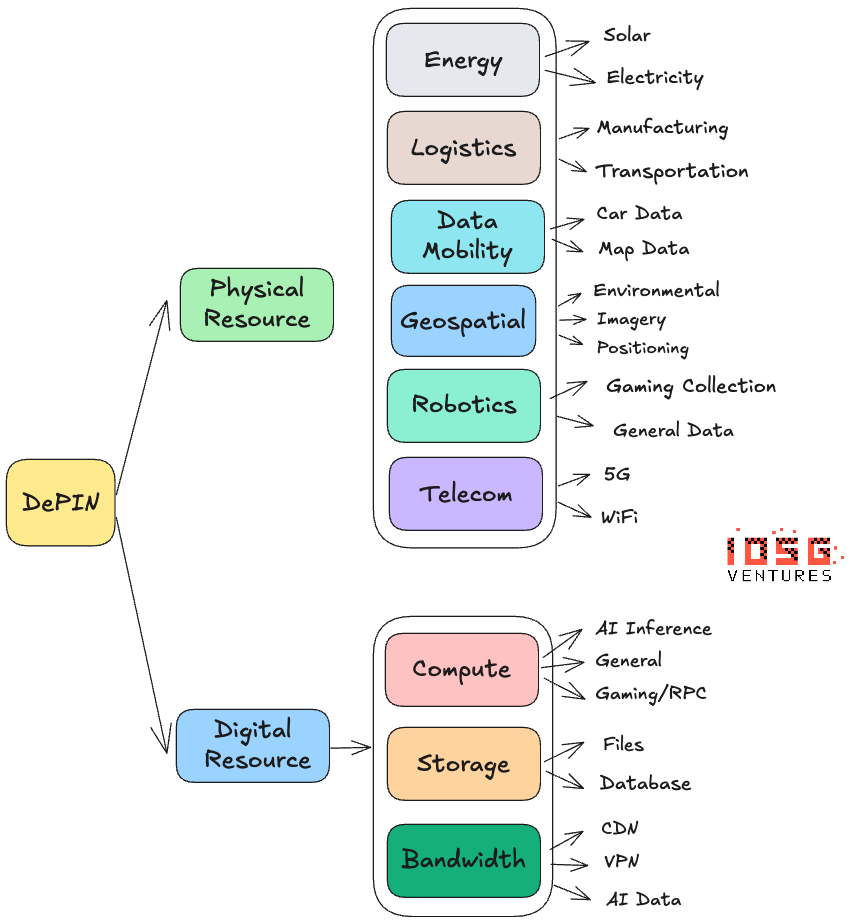
▲ Source: Messari, IOSG

Direction
From an intuitive perspective, 5G and wireless networks are large markets, while in-car data and weather data are smaller markets. From the demand side, we need to see if it is a necessity (5G) or has strong demand. Moreover, since the market share of something like 5G in the traditional market is very large, even if DePIN can capture a small portion of it, the market capacity under the Crypto scale is still considerable.
Product
According to Grayscale's report, the DePIN model is particularly suitable for industries with high capital requirements, high entry barriers, obvious monopolistic patterns, and underutilized resources. Answering the PMF question essentially looks at two points.
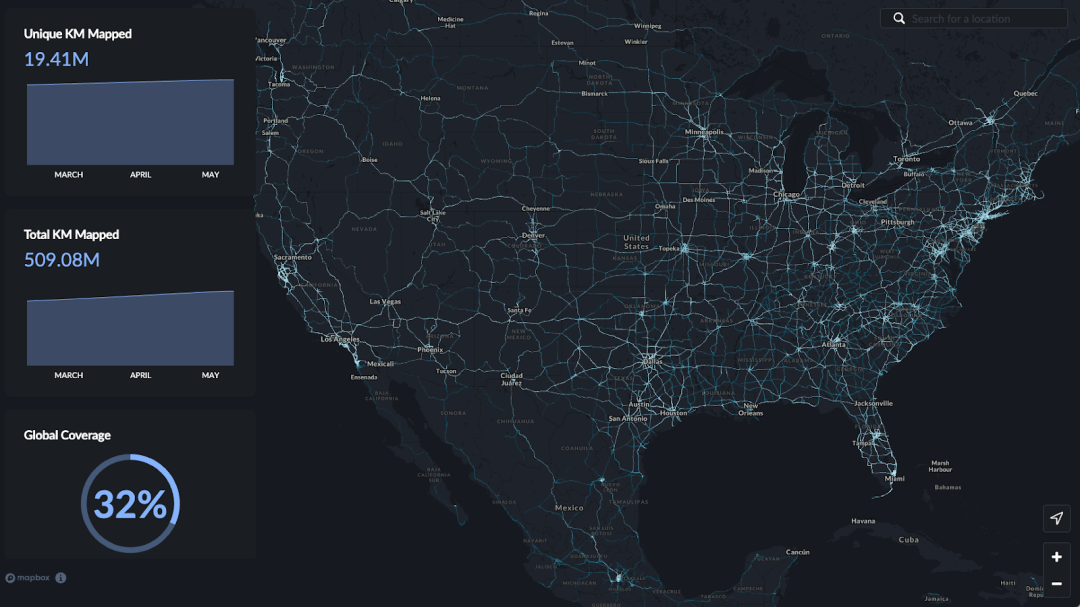
▲ Source: Hivemapper
On the supply side, whether DePIN can do things that were previously impossible or has outstanding advantages over existing solutions (cost, efficiency, etc.). For example, in the map collection track where Hivemapper operates, traditional map collection faces at least three major issues:
- Traditional methods rely on professional fleets and manual labeling, which are costly and have poor scalability.
- Google Street View has a long update cycle and low coverage in remote areas.
- Centralized map service providers monopolize data pricing power.
Hivemapper allows users to collect data by selling dash cams, turning data collection into something users do during their daily driving. Through token incentives, users are guided to prioritize resources in high-demand areas.
On the demand side, the products provided by DePIN must have real market demand, preferably with a strong willingness to pay. The same example applies: Hivemapper can sell map data to companies in autonomous driving, logistics, insurance, and municipalities, validating key demand.
Regarding hardware, Multicoin's 2023 article "Exploring The Design Space Of DePIN Networks" begins by discussing hardware. Here, I would like to add a few points of view.
The timeline for hardware can be summarized as "manufacture—sell—distribute—maintain."
#Manufacture
Should the project team design and manufacture hardware themselves, or use existing hardware? For example, Helium provides two types of its own hotspots and also supports integrating existing WiFi networks. Alternatively, computing and storage-related DePIN projects can directly use existing graphics cards and hard drives, etc.
#Sales
The clear pricing of sales means that users will calculate the payback period based on potential returns. Helium's home mobile hotspot is priced at $249, while DIMO's in-car data collector is priced at $1,331.
#Distribution
How to distribute? Distribution involves many uncertain factors: logistics timeliness, transportation costs, and the delivery cycle starting from pre-sales, etc. For projects targeting a global scope, inappropriate distribution design and methods can significantly slow down project progress.
#Maintenance
What do users need to do to maintain the hardware? Some devices may experience depreciation or wear and tear. The simplest maintenance example is Grass, where users only need to download a browser extension without requiring any other operations; or Helium's hotspots, which only need simple installation to continue operating. If solar power generation is involved, it may be more complex.
Considering the above points, the simplest model is Grass's model—directly utilizing existing network bandwidth, requiring no manufacturing and distribution, allowing users to start without barriers, and not needing sales, which helps to quickly expand the network in the early stages of the project.
Indeed, projects in each direction have different hardware needs. However, hardware relates to the friction of initial adoption. The less friction there is in the early stages of a project, the better; as the project matures, some friction can lead to retention and a certain degree of binding relationships. For startup teams, it is essential to control the path choices and resource investments in hardware, progressing gradually rather than all at once.
Imagine if "manufacturing—sales—distribution—maintenance" is not easy; then unless there are very strong and highly certain incentives, why would users want to participate?
Token Economics
The design of the token mechanism is one of the most challenging aspects of DePIN projects. Unlike projects in other fields, DePIN needs to incentivize various participants in the network early on, which requires launching tokens at a very early stage of the project. This topic is suitable for a new article to conduct some case studies, and this article will not elaborate further.
Team
In terms of team composition, the founder needs at least one person with the following backgrounds: one who has worked in traditional companies in this field with rich experience, responsible for technical and product-related practical matters, and another who is crypto-native, understands token economics and community building, and can distinguish between the preferences and mental models of crypto users and non-crypto users.
Others
Regulatory issues, such as collecting road images and data domestically, are obviously very sensitive.

Summary
Crypto has not truly "broken the circle" in this cycle; it seems we are still far from adoption by users outside the circle. Some short-term incentives provided by Crypto applications are the reasons users use them, but they cannot last. The economic benefits derived from the underlying DePIN may replace traditional infrastructure on the user side, thus achieving application sustainability and enabling large-scale adoption.
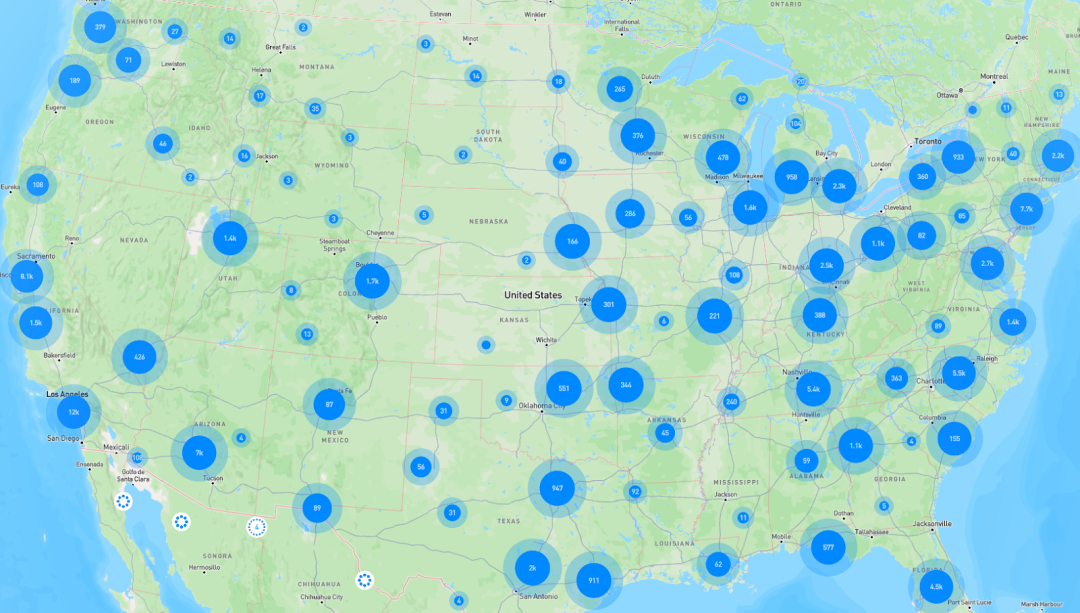
▲ Source: Helium
Although the characteristics of DePIN's integration with reality lead to a longer development cycle, we have already seen some glimmers of hope from the development of Helium Mobile: Helium Mobile has partnered with T-Mobile, allowing user devices to seamlessly switch to T-Mobile's nationwide 5G network. For example, when users leave the coverage area of Helium community hotspots, they automatically connect to T-Mobile base stations, avoiding signal interruptions. Earlier this year, Helium announced a partnership with global telecom giant Telefónica to deploy Helium Mobile 5G hotspots in Mexico City and Oaxaca, marking the beginning of its expansion in South America. Telefónica's subsidiary Movistar in Mexico has about 2.3 million users, and this partnership directly connects these users to Helium's 5G network.
In addition to the content discussed above, we also believe that DePIN has two unique advantages:
- Compared to traditional monopolistic large enterprises, DePIN has more flexible deployment methods and means, and can align incentives within the ecosystem through token models. For example, the traditional telecom industry is usually dominated by a few giants, lacking the motivation for innovation. In rural areas, for instance, due to the dispersed population, traditional operators have low investment returns and long timelines, leading them to lack the motivation to promote deployment. However, through appropriate token economic design, networks can be encouraged to deploy in areas with few hotspots. Hivermapper setting higher incentives in areas where map resources are scarce follows the same logic.
- DePIN has the potential to bring positive externalities. The purchase of internet data collected by Grass by AI companies, the purchase of street-level map data from Hivemapper by autonomous driving companies, and Helium Mobile providing low-cost data plans all demonstrate that DePIN can actually step outside the realm of Crypto to bring value to real life and other industries, and through token economics, feed back into the entire ecosystem. In other words, the tokens of DePIN are backed by real value, rather than being a Ponzi model.
Of course, DePIN also faces many uncertainties: for example, uncertainties in time cycles due to operating hardware, regulatory risks, due diligence risks, and so on.
In summary, DePIN is a track we will focus on in 2025, and we will continue to produce more research related to DePIN.
免责声明:本文章仅代表作者个人观点,不代表本平台的立场和观点。本文章仅供信息分享,不构成对任何人的任何投资建议。用户与作者之间的任何争议,与本平台无关。如网页中刊载的文章或图片涉及侵权,请提供相关的权利证明和身份证明发送邮件到support@aicoin.com,本平台相关工作人员将会进行核查。




